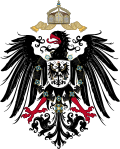| Order of St. George | |
|---|---|
 Star and cross of the Order of St. George | |
| Awarded by Kingdom of Hannover | |
| Type | House Order |
| Motto | Nunquam retrorsum (Never Backward) |
| Status | Currently awarded by the head of the House of Hanover |
| Grand Master | Ernst August, Prince of Hanover |
| Precedence | |
| Next (higher) | - |
| Next (lower) | Royal Guelphic Order |
| Ribbon of the order | |
The Order of St. George (German : Sankt Georgs-Orden), was founded by Ernest Augustus, King of Hanover, on 23 April 1839. [1] In the statutes establishing the order it was designated as the House Order of the Crown of Hanover. The order is of a single grade and limited to 16 members, excluding members of the royal family.


